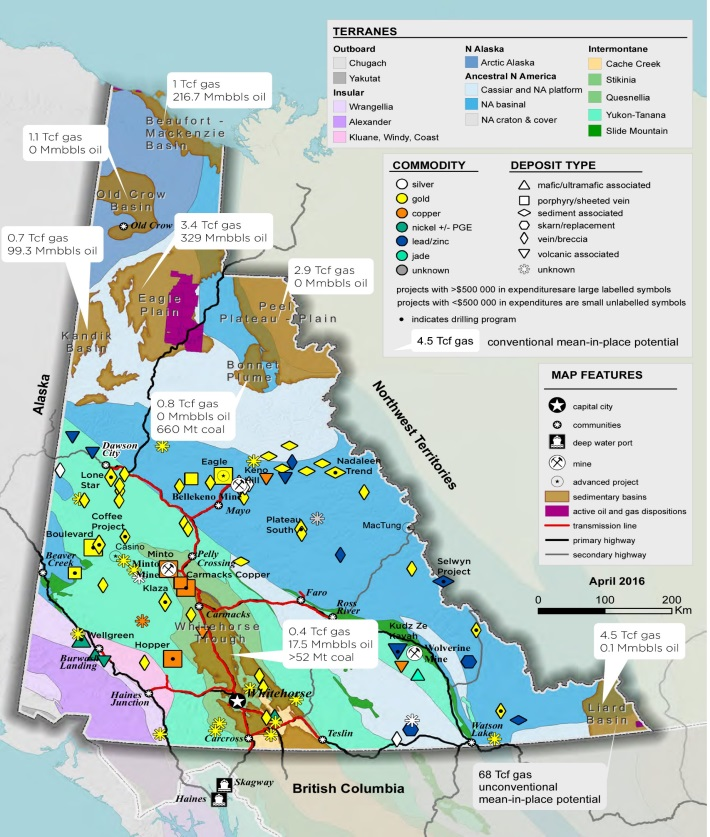
A product of the Energy and Mines Ministers’ Conference
Yukon’s Oil and Gas Resources

- 8 TRILLION CUBIC FEET
Technically Recoverable Natural Gas

- N/A MILLION BARRELS
Technically Recoverable Crude Oil

- 0 BILLION CUBIC FEET/DAY
Total Natural Gas Production (2013)- 0 BILLION CUBIC FEET/DAY
Shale/Tight Gas Production (2013)
- 0 BILLION CUBIC FEET/DAY

- 0 MILLION BARRELS/DAY
Total Crude Oil Production (2013)- 0 MILLION BARRELS/DAY
Tight Oil Production (2013)
- 0 MILLION BARRELS/DAY
Sources:
- Resource estimates: National Energy Board (2016)
- Production estimates: National Energy Board (may not align with territorial data due to differences in methodology)
Geography
Outcrop-based research by the Yukon Geological Survey suggests that shale hydrocarbon plays could exist in north Yukon in the Eagle Plain, Peel Plateau and Kandik basins. In Liard Basin in the southeast of the territory, two shale gas plays have been identified and their resources assessed in a multi-jurisdictional subsurface study coordinated by the National Energy Board. There is also speculative potential for coal bed methane, tight gas and unconventional shale plays in the Whitehorse trough in south-central Yukon; however, no detailed work has been conducted to characterize these plays within this basin to date.
Geology
In Yukon’s Liard Basin, the marketable unconventional gas potential of the Exshaw-Patry shale of the Besa River Formation has been evaluated in a joint assessment by the National Energy Board, the British Columbia Oil and Gas Commission, the British Columbia Ministry of Natural Gas Development, the Northwest Territories Geological Survey, and the Yukon Geological Survey. The thick and geographically extensive Upper Devonian to Mississippian Exshaw and Patry shales are expected to contain 6.20 trillion m³ (219 trillion cubic feet) of marketable natural gas in the basin, with 8 trillion cubic feet of marketable gas occurring in this play in Yukon. Shales of the deeper Horn River Group play were also assessed in Yukon’s Liard Basin for gas-in-place resource only (21 trillion cubic feet).
Although outcrop-based studies by the Yukon Geological Survey suggest favorable potential for both oil and gas in north Yukon, little is known about the subsurface unconventional hydrocarbon potential of this region due to a limited amount of petroleum industry activity and more of a focus on conventional exploration. A 2012 scoping study of unconventional hydrocarbon potential in Yukon identified numerous shale units that have reservoir characteristics capable of hosting large hydrocarbon resources and several situations where tight gas accumulations could exist. The Yukon Geological Survey is continuing to examine shale strata in these north Yukon basins, and in the Whitehorse trough, in order to better characterize their prospectivity.

Figure 1: Terrane Map of Yukon Territory with Oil and Gas Regions
Overlain in Brown, and Including 2015 Mining and Exploration Activity
Source: Used with the permission of the Department of Energy, Mines and Resources, Yukon Government
Text version
Figure 1: Terrane Map of Yukon Territory with Oil and Gas Regions
Map of the Yukon’s terranes which highlights the major oil and gas regions and mining and exploration activities in 2013. The Eagle Plain Basin and the Liard Basin have the largest natural gas resources in the territory.
Exploration and Production
Two companies are currently working in Yukon: EFLO Energy Inc. (EFLO) in Liard Basin and Northern Cross (Yukon) Ltd. in Eagle Plain Basin. EFLO has publicly stated they have interest in pursuing shale resources within Liard Basin. Northern Cross is targeting conventional sandstone reservoirs in the Carboniferous Hart River Formation in Eagle Plain Basin. There is currently no active exploration in Liard Basin, gas production from conventional reservoirs in this basin ceased in 2012.
Regulation
The Oil and Gas Act (OGA) (PDF, 679 KB) is the legislation that regulates all oil and gas activities in Yukon.
Within OGA, Yukon’s Drilling and Production Regulations (PDF, 1.4 MB) govern any exploration and production of shale oil and gas resources. At this point, there is no differentiation within the Act or regulations between shale and conventional resources.
Other Yukon legislation such as the Waters Act (PDF, 356 KB), Environment Act and Lands Act (PDF, 174 KB) may also play a role in the regulation of shale resources.
